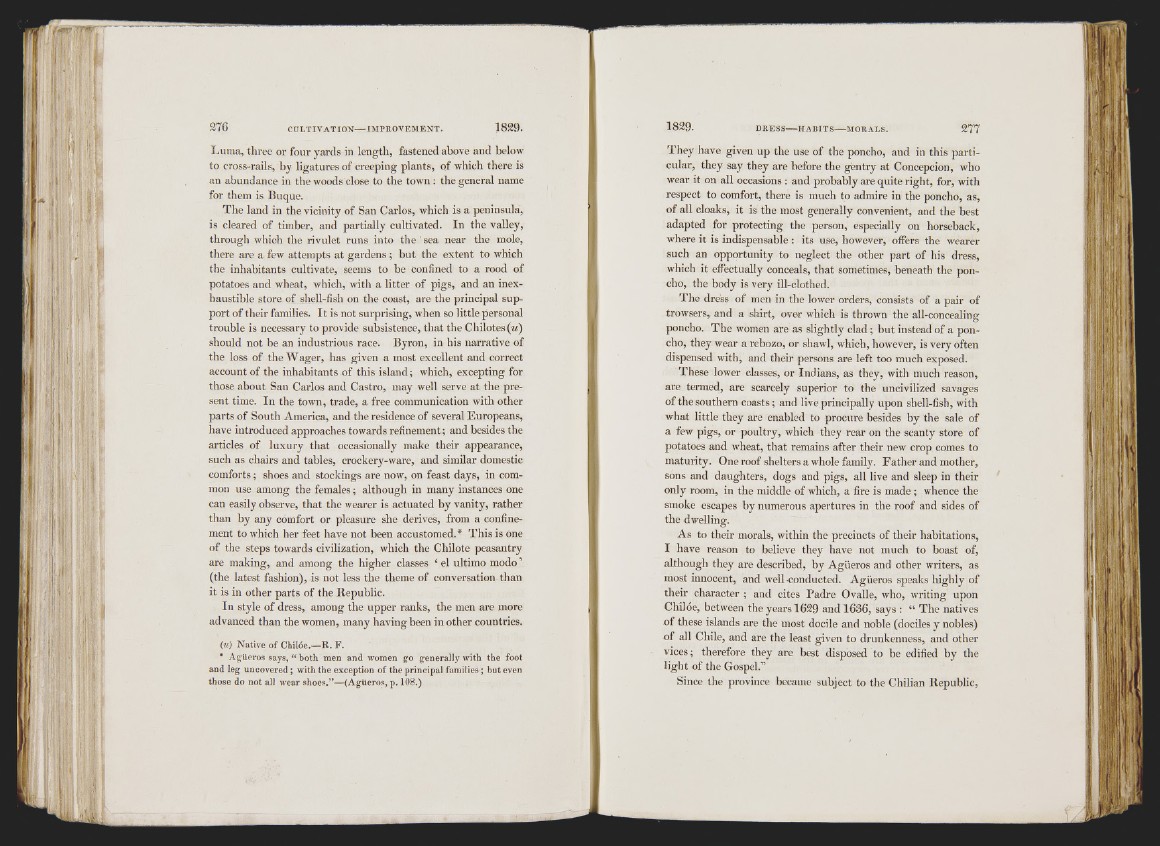
I t • t-
I I j!
Luma, three or four yards in length, fastened above and below
to cross-rails, by ligatures of creeping plants, of which there is
an abundance in the woods close to the town : the general name
for them is Buque.
The land in the vicinity of San Carlos, which is a peninsula,
is cleared of timber, and partially cultivated. In the valley,
through which the rivulet runs into th e ' sea near the mole,
there are a few attempts at gardens; but the extent to which
the inhabitants cultivate, seems to be confined to a rood of
potatoes and wheat, whicli, with a litter of pigs, and an inexhaustible
store of shell-fish on the coast, are the principal support
of their families. It is not surprising, when so little personal
trouble is necessary to provide subsistence, that the Chilotes(M)
should not be an industrious race. Byron, in his narrative of
the loss of the Wager, has given a most excellent and correct
account of the inhabitants of this island; which, excepting for
those about San Caídos and Castro, may well serve at the present
time. In the town, trade, a free communication with other
parts of South America, and the residence of several Europeans,
have introduced approaches towards refinement; and besides the
articles of luxury that occasionally make their appearance,
such as chairs and tables, crockery-ware, and similar domestic
comforts; shoes and stockings are now, on feast days, in common
use among the females; although in many instances one
can easily observe, that the wearer is actuated by vanity, rather
than by any comfort or pleasure she derives, from a confinement
to which her feet have not been accustomed.* This is one
of the steps towards civilization, which the Chilote peasantry
are making, and among the higher classes ‘ el ultimo modo ’
(the latest fashion), is not less the theme of conversation than
it is in other parts of the Republic.
In style of dress, among the upper ranks, the men are more
advanced than the women, many having been in other countries.
(a) Native of Chilóe.—B. F.
* Agüeros says, “ both men and women go generally with the foot
and leg uncovered ; with the exception of the p rincipal families ; but even
those do not all wear shoes.”—(Agüeros, p. 108.)
They have given up the use of the poncho, and in this particular,
they say they are before the gentry at Concepcion, who
wear it on all occasions : and probably are quite right, for, with
respect to comfort, there is much to admire in the poncho, as,
of all cloaks, it is the most generally convenient, and the best
adapted for protecting the person, especially on horseback,
where it is indispensable ; its use, however, offers the wearer
such an opportunity to neglect the other part of his dress,
which it effectually conceals, that sometimes, beneath the poncho,
the body is very ill-clothed.
The dress of men in the lower orders, consists of a pair of
trowsers, and a shirt, over which is thrown the all-concealing
poncho. The women are as slightly clad ; but instead of a poncho,
they wear a rebozo, or shawl, which, however, is very often
dispensed with, and their persons are left too much exposed.
These lower classes, or Indians, as they, with much reason,
are termed, are scarcely superior to the uncivilized savages
of the southern coasts; and live principally upon shell-fish, with
what little they are enabled to procure besides by the sale of
a few pigs, or poultry, which they rear on the scanty store of
potatoes and wheat, that remains after their new crop comes to
maturity. One roof shelters a whole family. Father and mother,
sons and daughters, dogs and pigs, all live and sleep in their
only room, in the middle of which, a fire is made ; whence the
smoke escapes by numerous apertures in the roof and sides of
the dwelling.
As to their morals, within the precincts of their habitations,
I have reason to believe they have not much to boast of,
although they are described, by Agüeros and other writers, as
most innocent, and well-conducted. Agüeros speaks highly of
their character ; and cites Padre Ovalle, who, writing upon
Chilóe, between the years 1629 and 1636, says : “ The natives
of these islands are the most docile and noble (dóciles y nobles)
of all Chile, and are the least given to drunkenness, and other
vices; therefore they are best disposed to be edified by the
light of the Gospel.”
Since the province became subject to the Chilian Republic,